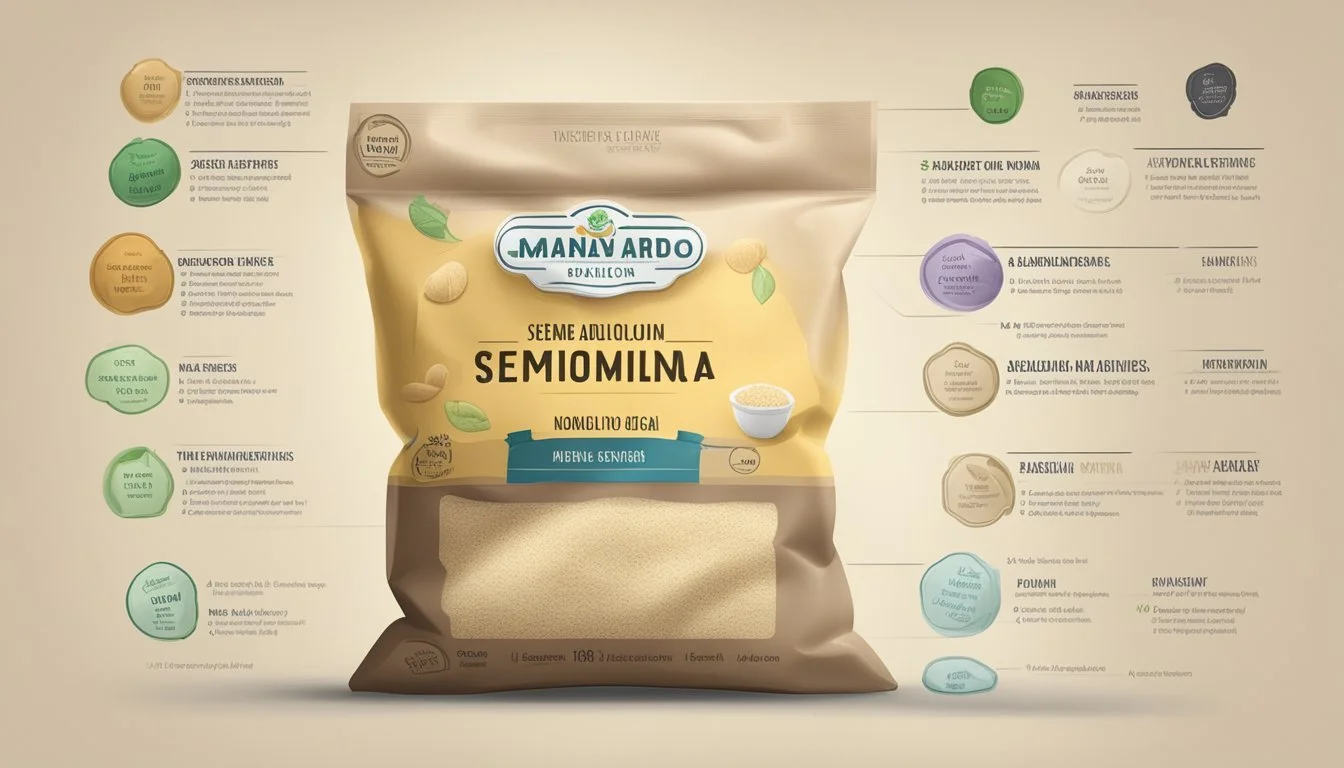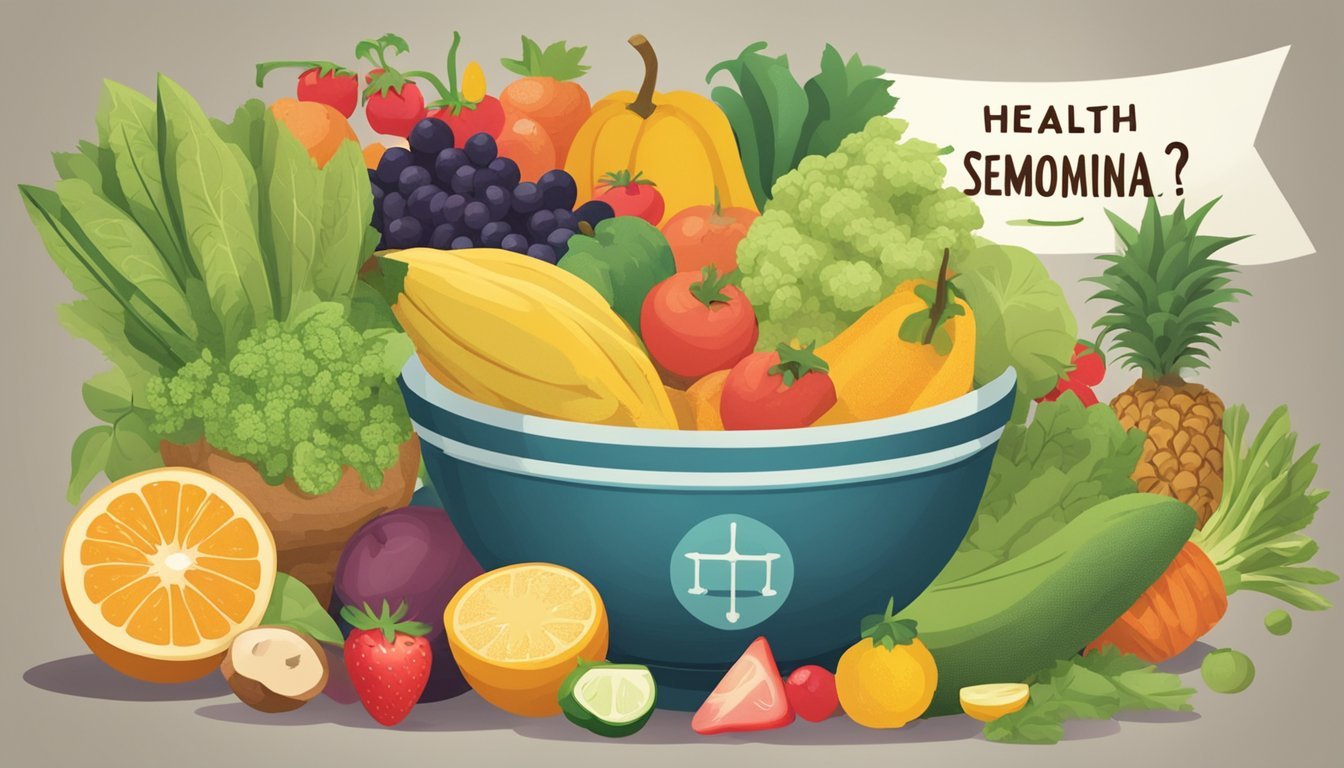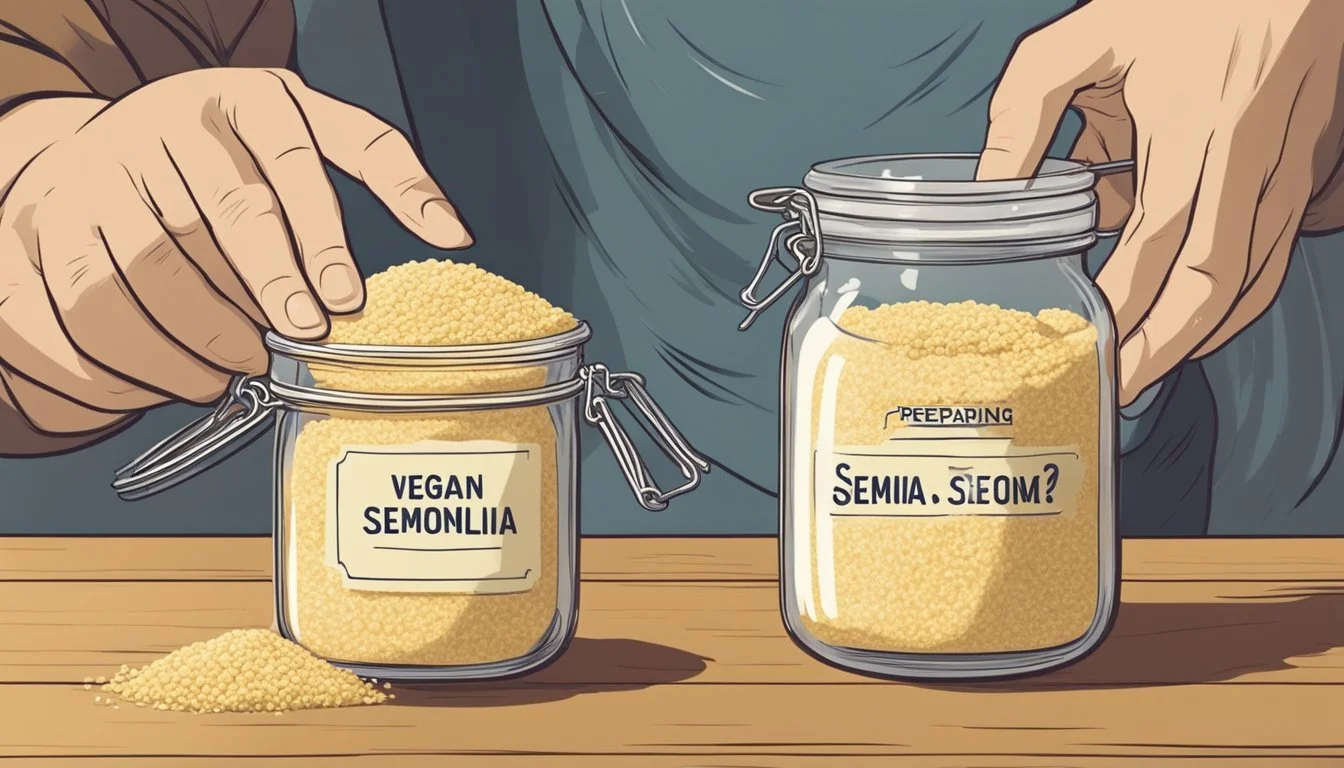Is Semolina Vegan?
Unveiling the Plant-Based Status of This Wheat Product
Semolina is a flour made from durum wheat, a hard type of wheat that has a higher protein content than common wheat. It's a popular ingredient in a range of foods, from pastas to breads and desserts. Individuals following a vegan lifestyle abstain from using animal products in their diet, which raises questions about the suitability of various food ingredients.
In the case of semolina, it is indeed vegan, as it is derived from a plant source and does not involve the use of animal products or by-products in its production. This makes it a suitable option for those on a strict vegan diet. Semolina offers nutritional benefits as it contains fiber, protein, and essential vitamins such as the B vitamins, iron, and magnesium, contributing to a balanced vegan diet.
What Is Semolina?
Semolina is the coarsely ground endosperm of durum wheat, a hard variety of wheat. It is a staple ingredient commonly used in Mediterranean, Middle Eastern, and Indian cuisine. Because of its high gluten content, semolina is prized for its firm texture and resistance to overcooking, which is particularly beneficial in making pasta and couscous (What wine goes well with couscous?).
Nutritionally, semolina offers a robust profile. It's a rich source of carbohydrates, which provide essential energy. Semolina also contains a decent amount of protein, contributing to its nutritional value.
Beyond providing energy and protein, semolina offers several micronutrients. It includes iron, which is pivotal for oxygen transport in the body, and B vitamins, important for various metabolic processes. Additionally, being made from wheat, semolina carries a considerable amount of fiber, aiding in healthy digestion.
Nutrient Benefit Carbohydrates Energy provision Protein Muscle repair and growth Iron Oxygen transport B vitamins Metabolic regulation Fiber Digestive health
It should be noted that semolina is not gluten-free, so it is not suitable for individuals with celiac disease or gluten sensitivity. However, for those who are seeking to incorporate plant-based ingredients into their diets, semolina is inherently vegan. It does not contain, nor is it produced from, any animal products or byproducts, making it a versatile choice for vegan cooking and baking.
Understanding Veganism
Veganism is a dietary and lifestyle choice that excludes the use of animal products. Individuals who follow a vegan diet consume plant-based foods while avoiding meat, dairy, eggs, and other substances derived from animals. This lifestyle is rooted in ethical considerations, environmental concerns, and health reasons.
The vegan diet consists of fruits, vegetables, legumes, grains, nuts, and seeds. Dairy-free alternatives such as almond milk, soy cheese, and coconut yogurt are also prevalent in a vegan pantry.
Ethical considerations form a significant part of veganism. Many vegans choose this lifestyle to promote animal welfare, objecting to the exploitation and harm of living beings for food, clothing, or any other purpose.
Environmental concerns are another driving factor, as plant-based diets typically require fewer resources and produce less greenhouse gas emissions compared to diets including animal products.
Health-conscious individuals may adopt a vegan diet due to its potential benefits, which include lower risks of heart disease, hypertension, type 2 diabetes, and certain types of cancer.
The practice of veganism extends beyond diet to the rejection of all animal-derived products, such as leather and wool, and products tested on animals.
In their menu planning and product selection, vegans are vigilant in checking labels for non-vegan ingredients, such as gelatin, casein, and certain food additives that are animal-derived.
Semolina in Vegan Cooking
Semolina, derived from durum wheat, serves as a versatile and plant-based ingredient compatible with vegan diets. It is often utilized in a multitude of recipes, ranging from starters to desserts. Within vegan cooking, semolina's role is vital due to its high protein content and robust texture, enhancing the nutritional value and mouthfeel of vegan dishes.
Recipes That Feature Semolina in Vegan Cooking:
Bread: Semolina can be incorporated into vegan bread recipes, contributing to a crusty texture and a golden color.
Pasta: Many vegan pasta dishes use semolina as the base, appreciated for its firm texture and ability to hold shape.
Pizza: For vegan pizza, a semolina-flour crust offers an excellent crispiness that elevates the dining experience.
Couscous: Semolina is the main ingredient in couscous, popular in vegan cooking for its versatility and quick preparation.
Desserts and Sweet Treats:
Semolina is not only relegated to savory dishes; it also excels in sweet applications:
Pudding: Vegan semolina pudding can be enjoyed as a comforting dessert or breakfast, with non-dairy milk and sweeteners like agave.
Cakes: Vegan semolina cakes offer a delightful texture, often paired with fruit and natural sweeteners to create a satisfying dessert or snack.
Usage Tips:
Cooking: To prevent lumps, semolina should be stirred continuously when added to liquids.
Flavoring: It pairs well with plant-based milks and sweeteners, spices, and fruits to customize the taste.
In conclusion, semolina's adaptability makes it a substantial ingredient for vegan cooking, suitable for a vast array of recipes that are both nourishing and enjoyable.
Common Non-Vegan Additives
When assessing whether semolina products are vegan, one must be vigilant about certain additives that are commonly derived from animal sources. These can include dairy, certain sugar refinement processes, and miscellaneous ingredients often hidden in everyday food items.
Dairy and Eggs in Semolina Products
Semolina flour is derived from durum wheat and is naturally vegan. However, manufacturers may incorporate milk, butter, cheese, or eggs into semolina products to enhance flavor or texture. Vegan consumers should specifically check product labels for these additions, especially in ready-to-eat items such as pasta or baked goods.
Refined Sugar Processing
It's important for vegans to note that not all sugar is processed equally; some refined sugar is processed using bone char from animal bones. While semolina itself does not contain sugar, products made with semolina might use such sugars, affecting their vegan status. The sugar in question is often listed as an ingredient in sweetened semolina dishes and desserts.
Additional Non-Vegan Ingredients
Beyond dairy and sugar, several other non-vegan ingredients may be present in semolina products:
E-numbers: E-Numbers such as E901 (beeswax) can be of animal origin, serving different functional purposes like glazing or stabilizing agents.
Food colorings: Some colorings like E153, which can be sourced from animal charcoal, may be present in colored semolina products.
Consumers should verify the source of these ingredients or look for certifications to ensure the product aligns with vegan principles.
Vegan-Friendly Semolina Recipes
Semolina is a versatile ingredient that can be incorporated into numerous vegan dishes, ranging from sweet desserts to hearty main courses and satisfying breakfast options. Whether one is looking to indulge in a post-dinner treat or seeking a nutritious start to the day, there are many ways to enjoy semolina in a plant-based diet.
Vegan Semolina Desserts
Recipes for vegan semolina pudding offer a comforting and creamy dessert option. The traditional dessert can be easily made vegan by using plant-based milk, such as almond or soy, and replacing honey with agave syrup. A simple version could involve bringing the plant milk to a boil, adding semolina, and whisking until thickened, followed by sweeteners like agave syrup or sugar, and flavor enhancers like vanilla extract.
A vegan semolina cake provides a sweet and satisfying treat that can be customized with fruits or spices. One can prepare the cake batter with fine semolina, plant-based milk, baking powder, and sweeteners, and then infuse it with flavor additions such as lemon zest or orange blossom water. Baking it results in a moist and dense texture characteristic of this delightful dessert.
Main Dishes and Breads
Semolina's utility in savory vegan dishes is evident in its use in making pasta and gnocchi. Its robust texture is ideal for creating firm and satisfying pasta shapes or soft, pillowy gnocchi, which are complemented well by various sauces and vegetables.
It can also be utilized as a base for vegan breads. Semolina flour imparts a slightly sweet, nutty flavor to bread, and its high gluten content yields a chewy texture. Classic bread recipes can be adapted by substituting dairy and eggs with vegan alternatives such as plant-based milk and flax eggs to maintain the bread's integrity and flavor.
Breakfast and Porridge Options
For a warm and nourishing start to the day, semolina porridge serves as an excellent breakfast option. It can be simmered in plant-based milk and stirred continuously to achieve a smooth, creamy consistency. Sweetening ingredients, like maple syrup and cinnamon, can be added for flavor. The porridge can also be topped with fresh or dried fruits and nuts for added nutrition and texture.
In conclusion, semolina’s flexibility in the kitchen makes it a staple for those following a vegan diet, allowing for a wide array of recipes that cater to any meal of the day.
Substituting Non-Vegan Ingredients
When preparing semolina dishes, it's important to identify and replace ingredients that are not vegan-friendly. Dairy products, commonly used in semolina recipes, can easily be substituted with plant-based alternatives without compromising taste or texture.
Milk: Traditional semolina recipes often call for milk. To maintain a vegan standard, one can replace cow's milk with an array of plant-based milks. They include:
Almond milk: Adds a hint of nuttiness and is low in calories.
Soy milk: High in protein and has a creamier consistency.
Coconut milk: Brings a tropical aroma and rich texture.
Dairy Milk Vegan Substitute Whole/full-fat Coconut milk Skim/low-fat Almond milk Creamy texture Soy milk
Butter and Margarine: To achieve the desired fatty richness in vegan semolina dishes, dairy butter should be replaced by vegan butter or margarine. These are made from plant oils and are free from dairy products.
Vegan Butter: Rich and perfect for baking or adding to creamy dishes.
Margarine: More adaptable for a variety of recipes and easy to find.
When selecting margarine, ensure it is labeled "dairy-free," as some brands may include animal-derived ingredients.
Sweeteners: Some semolina dessert recipes might include honey, which is not considered vegan. Suitable vegan alternatives include:
Agave syrup
Maple syrup
Replacing non-vegan ingredients doesn't mean sacrificing flavor or enjoyment of semolina-based dishes. By choosing the right plant-based alternatives, anyone can create delicious, vegan-friendly meals.
Gluten Content in Semolina
Semolina is a coarse flour made from durum wheat, a hard type of wheat. When discussing semolina's relationship with gluten, it is essential to understand that it inherently contains a substantial amount of gluten. Gluten is a group of proteins found in wheat and related grains like barley and rye. In the context of semolina, gluten is responsible for providing elasticity and chewiness to foods made from this type of flour.
For those following a gluten-free diet due to health reasons such as celiac disease or non-celiac gluten sensitivity, semolina would not be an appropriate choice. Celiac disease is an autoimmune disorder where the ingestion of gluten leads to damage in the small intestine.
Here is a brief overview of semolina and its gluten-related aspects:
Source: Durum wheat
Gluten Presence: High
Suitable for Celiac Disease: No
Suitable for Non-Celiac Gluten Sensitivity: No
It is worth noting, however, that numerous gluten-free alternatives are available on the market which mimic the properties of semolina without the gluten content. These alternatives are typically made from grains and flours such as rice, corn, and quinoa.
In summary, semolina flour does contain gluten, which is a key consideration for individuals with gluten-related disorders. Since it is made from a type of wheat, it is unsuitable for those who require a gluten-free diet.
Health Benefits of Semolina
Semolina, the coarse flour derived from durum wheat, is recognized for its nutritional profile, which includes a rich array of vitamins and minerals beneficial for health. It's a particularly good source of protein, offering value for those on a vegan diet by contributing towards muscle maintenance and growth.
Rich in B vitamins, semolina can contribute to the proper functioning of the body's metabolism. B vitamins like thiamin and folate are instrumental in energy production and the formation of red blood cells. Semolina's iron content, essential for oxygen transport in the body, complements the energy-boosting effects of B vitamins.
Fiber is yet another crucial component of semolina, promoting digestive health and helping to provide a feeling of fullness after meals, which can aid in weight management. The presence of fiber also supports sustained energy release, making semolina a valuable food for sustained energy throughout the day.
Nutrient Relevance Protein Builds and repairs tissue Fiber Aids in digestion and satiety Iron Necessary for blood health B Vitamins Supports metabolic processes
With its nutritious composition, semolina can be a welcome addition to a vegan diet, contributing essential nutrients without the need for animal products. Whether incorporated into pasta, bread, or other culinary dishes, semolina remains a versatile and healthful ingredient.
Shopping for Vegan Semolina Products
When shopping for vegan semolina products, consumers should focus on the ingredient list. Semolina itself is made from durum wheat, making it a plant-based ingredient suitable for vegans. However, they must be vigilant when it comes to processed semolina products, as these often include non-vegan ingredients such as dairy products.
To ensure that semolina products are vegan:
Check Labels Carefully: Look for any dairy derivatives, including milk, cheese, or eggs, listed in the ingredients.
Seek Certification: Vegan certification symbols on the packaging can guarantee the absence of animal products.
Research Brands: Some brands are dedicated to vegan products; familiarizing oneself with those can make shopping easier.
Here is a quick reference guide:
Ingredient to Avoid Common in Milk Semolina puddings, pasta dishes Eggs Certain varieties of semolina pasta Cheese Gnocchi and flavored semolina products
Consumers should be mindful that even if semolina is the main ingredient, the presence of additives meant to enhance flavor or texture can compromise its vegan status. Therefore, reading labels remains a crucial step. If uncertainty arises, one can opt for whole semolina grains and create dishes from scratch.
In conclusion, while semolina is inherently vegan as a raw material, due diligence is necessary when purchasing processed foods containing semolina to ensure these products align with vegan dietary requirements.
Preparing and Storing Semolina
Semolina, a versatile wheat product, plays an integral role in vegan cuisine. Optimal preparation techniques and proper storage methods are crucial for maintaining semolina's texture and freshness.
Cooking Techniques for Semolina
Dry Roasting: For a rich, nutty flavor, one can dry roast semolina over a low to medium flame, stirring continuously to prevent burning, until it achieves a golden hue. This process typically takes about 3-4 minutes.
Boiling: When making semolina pudding or similar dishes, the robust grain is often simmered in plant-based milk. It is essential to stir regularly to encourage an even cooking process and control the consistency—thickening the mixture to the desired level, usually within 8-10 minutes.
Storing and Reheating Semolina
Refrigeration: Semolina dishes should be stored in an airtight container and can be kept fresh in the refrigerator for up to five days. Make sure the semolina has cooled to room temperature before sealing it for storage.
Freezing: For long-term storage, one can freeze semolina dishes. They should be portioned, covered in an airtight container or heavy-duty freezer bags, and can be stored for up to three months.
Reheating: Semolina dishes reheat well on the stove or in a microwave. It's recommended to add a small amount of water or plant-based milk when reheating to restore its consistency. Heat it until it's thoroughly warm, stirring occasionally to ensure even reheating.
Exploring Cultural Semolina Dishes
Semolina is a versatile ingredient embraced by diverse cultures to create an array of traditional dishes, each reflective of their culinary heritage. One finds its prominence in Middle Eastern cuisine, where semolina is central to desserts like Namoura and Basbousa, sweet cakes often flavored with rose water or orange blossom and soaked in syrup.
Italian cuisine has adopted semolina in the form of gnocchi, small, doughy pasta pieces, often rolled out and cut by hand. Semolina's firm texture makes it ideal for maintaining the gnocchi's shape during cooking.
North African dishes boast of semolina in the form of couscous, tiny granules that are steamed and typically served with vegetables or meats. Couscous is not only a staple in daily meals but also features in festive and ceremonial settings.
In the context of veganism, semolina shines for its plant-based origins. It’s crafted from the endosperm of durum wheat, making it inherently vegan and a suitable component in vegan recipes where one might use more refined flours.
Region Dish Highlight Middle East Namoura, Basbousa Sweet, syrup-soaked semolina cakes Italy Gnocchi Doughy pasta made with semolina North Africa Couscous Steamed semolina granules as a main course
Furthermore, variations of semolina pudding, often characterized by a comforting creaminess, can be found in British cuisine and are easily adaptable to vegan diets with plant-based milk substitutes.
The aforementioned culinary uses of semolina underscore its universal appeal across a spectrum of dishes, be it savory or sweet, underscoring the grain's adaptability and the rich cultural tapestry it weaves into the global food scene.
Semolina for Special Dietary Needs
Semolina flour, made from durum wheat, caters to various dietary requirements, particularly for those following a vegan lifestyle. Its plant-based origin ensures compatibility with vegan diets, but individuals with other dietary needs, such as low-fat, low-sugar, or allergy-related restrictions, may also find relevant options and substitutes.
Low-Fat and Low-Sugar Semolina Options
Semolina is naturally low in fat, making it a suitable choice for those on a low-fat diet. Given its minimal sugar content, it is also an excellent ingredient for a low-sugar diet. These characteristics make semolina a versatile base for creating balanced meals. To ensure a meal keeps within these dietary parameters, one should pair semolina with low-fat and low-sugar accompaniments.
For a low-fat recipe: Opt for vegetables or legumes as accompaniments.
For a low-sugar recipe: Avoid adding sugars or sweeteners and rely on the natural flavor of the semolina.
Semolina Substitutes for Allergies and Intolerances
Those with allergies or intolerances may need alternatives to semolina. Gluten intolerance necessitates a gluten-free substitute since semolina contains gluten.
For nut allergies: Semolina is nut-free, but cross-contamination with nuts can occur during processing. It is important to select brands that ensure a nut-free environment to avoid this issue.
For gluten intolerance: Consider gluten-free grains like quinoa flour, rice flour, or buckwheat flour as substitutes. They provide similar textural properties for recipes traditionally using semolina.
Allergy/Intolerance Recommended Substitute Nut Allergies Nut-free labeled semolina Gluten Intolerance Quinoa, Rice, Buckwheat Flour
Substitutes should be chosen based on their ability to provide a similar consistency and flavor profile to semolina, ensuring the dietary needs are met without compromising the quality of the dish.











